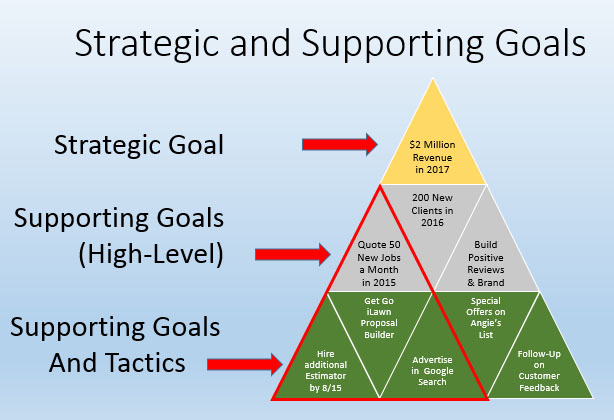Setting (and Using) Strategic Goals
How do you optimize your business to make the most money you can from your hard work? How do you plan for the long term? Where do you want your business to be next year, or 3 years in the future?
Each business owner probably already has very specific ideas about the future of their business, but many don’t see value in making these goals “official”.
Why it Matters –
Formalizing your goals helps keep your eyes on the big picture, helps you operationalize to be efficient, and gives you an objective tool to evaluate your progress later.
Sure a small business owner might be able to operate without goals if customers keep calling and revenues cover costs, but can they grow? And how much might they be missing?
At Go iLawn and Go iPave, we want to see our customers succeed, because as you grow, so do we. With this in mind, we’re providing four suggestions for setting basic company goals.
1. Start With Your Strategic Goals –
These are the big ones… like how much do I want to try to grow my business, and what level of profit do I plan to make? You can express this as a growth rate (I want to grow at 25% per year), or I prefer to set an end point goal for the current planning cycle.
Each company has to find their own strategic goals based on their unique circumstances and needs. Fortunately, each company probably already has strategic goals built into a vision of the company’s future.
Ask yourself two things… what is my company like in the future, and when is this new future? Describe it. Address basic questions like how many employees work for this company, who are your customers, and what all do you sell them? Ask lots of questions… be specific… write the answers down… use this model to drive decisions.
For a top-level goal, you can say something simple like “I want to do $2 Million in business by 2017”. The important things here are to:
- Set a goal for what your company will become …and…
- Define when you want to reach that place.
2. Set Supporting Goals –
High-level supporting goals are critical. Think of these as the “how am I going to get there” in your planning process. This is the most-difficult part of planning, where you start linking your vision of the future to the actions of today. So setting good supporting goals helps keep your daily decisions in line with your long-term vision.
Say you have 200 customers now and a $1million business. To reach $2million by 2017, you’ll need to add 200 more customers in 2016. And how will you do that? If your plan is to get there by quoting 50 new customers a month and generating positive customer reviews and a strong brand, those are supporting goals, and each requires multiple actions to achieve them.
… and Build Layers of Supporting Goals –
Each of your supporting goals leads directly to meeting the bigger goal. You can have multiple layers of supporting goals, each supporting the ones above it. So to generate 50 quotes a month for example, you plan to add a new estimator, you need to get more efficient through software, and you need to advertise to generate more leads.
Here’s an illustration of this simple goals pyramid:
Supporting goals also help you prioritize investments. As you look toward this bright future, where do you see gaps? What does this future company do that you don’t do already? How are you going to bridge those gaps and when will you do it? For example, you’ve been planning to buy a new piece of equipment in September.
Ask yourself these questions:
- How will that help you make $2 million in 2017?
- Does it help you provide a new service to expand or win more jobs?
- Does it help you put another crew into action and complete more jobs faster?
- Does it support your base operations and make your field crews more efficient?
If you can’t relate this large purchase to a specific goal, maybe you should reconsider it.
3. Keep Your Goals Simple and Few –
One of the key benefits of goal setting is to help you focus. Trying to pursue too many goals at the same time can be as bad as not pursuing any. Keep your high-level goals few, so you can focus on them.
This may require hard decisions about which goals to pursue now and which to defer until later, so prioritization is also important. We recommend no more than a dozen upper-level goals, which all support your top-level strategic goal.
4. Make Sure Your Goals are SMART –
SMART goals have been used in business since the 1980s, and the SMART test is a great way to validate the goals you set. When setting goals at any level, the SMART test helps you ensure that your goals can be effective.
Ask yourself if your goals are:
Specific – What is expected, why is it important and who is going to do it?
Measurable – How will I know if it’s done? How will I know if we’re on track?
Achievable – Is it possible and realistic to succeed?
Relevant – Will achieving this goal drive you toward a meaningful objective?
Time-Based – Specifically, when will the goal be met… or be un-met but finished?
If each goal can adequately identify the who, why and what; if it can be measured objectively, if it is within the range of what is possible, if it is relevant to your larger-picture objectives, AND, if it can be targeted at a specific timeframe, it can be a SMART goal. If it fails any one of these tests, keep working.
Keep Planning –
Our basic model doesn’t replace a more formal and rigorous planning process, but for those of you just starting a formal plan, these suggestions could help structure planning the growth of your business.
And once you find a system that works for you, use it to create annual and quarterly goals to plan out your growth from year to year and from season to season.











Leave a Reply
Want to join the discussion?Feel free to contribute!